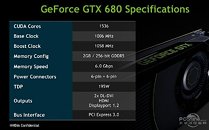Tuesday, March 13th 2012

GeForce GTX 680 Specifications Sheet Leaked
Chinese media site PCOnline.com.cn released what it claims to be an except from the press-deck of NVIDIA's GeForce GTX 680 launch, reportedly scheduled for March 22. The specs sheet is in tune with a lot of information that we already came across on the internet, when preparing our older reports. To begin with the GeForce GTX 680 features clock speeds of 1006 MHz (base), and 1058 MHz (boost). The memory is clocked at a stellar 6.00 GHz (1500 MHz actual), with a memory bus width of 256-bit, it should churn out memory bandwidth of 192 GB/s. 2 GB is the standard memory amount.
For the umpteenth time, this GPU does feature 1,536 CUDA cores. The card draws power from two 6-pin PCIe power connectors. The GPU's TDP is rated at 195W. Display outputs include two DVI, and one each of HDMI and DisplayPort. Like with the new-generation GPUs from AMD, it supports PCI-Express 3.0 x16 bus interface, which could particularly benefit Ivy Bridge and Sandy Bridge-E systems, in cases where the link width is reduced to PCI-Express 3.0 x8 when there are multiple graphics cards installed.
Source:
PCOnline.com.cn
For the umpteenth time, this GPU does feature 1,536 CUDA cores. The card draws power from two 6-pin PCIe power connectors. The GPU's TDP is rated at 195W. Display outputs include two DVI, and one each of HDMI and DisplayPort. Like with the new-generation GPUs from AMD, it supports PCI-Express 3.0 x16 bus interface, which could particularly benefit Ivy Bridge and Sandy Bridge-E systems, in cases where the link width is reduced to PCI-Express 3.0 x8 when there are multiple graphics cards installed.

44 Comments on GeForce GTX 680 Specifications Sheet Leaked
Was expecting high clocks and no... hotclocks. The boost is somehow... small?
I'm aware that the new 28nm process brings several benefits to the table, but I really doubt that the new process plus tweaks on NVIDIA's architecture would make viable for them to get roughly three times as much CUDA cores to work at ~1GHz.
Let's just wait for official numbers.
I'm still laughing at the fact that the "chocolate" was in fact a cookie. That mis-conception alone, based on appearances, says quite a bit.
anyways, 1536 with 1000 mhz on 195W tdp is abit hard on my brain, not saying it's impossible.
either they are giving up tesla or making a diffrent gpu tree for that if it's true is my guess then.
Nevertheless, I'd be really impressed if NVIDIA would actually get along with the numbers shown on that spec. sheet, but what I really can't understand (considering that leaked slide to be authentic) is why would NVIDIA favour a lower TDP when they could just crank up some more CUDA cores or even clocks to extend their possible performance leadership?
I always use the same example and I know it's not about SPs, but it's one of the most clear ones I can find in recent history, and everything applies to electronics to some extent:
www.anandtech.com/show/3987/amds-radeon-6870-6850-renewing-competition-in-the-midrange-market/2"By reducing their desired shader speeds from 1.6 Ghz to 1 Ghz, Nvidia was able to reduce the size of their shader processors by nearly 50%" sounds alien in the light of the above fact? Not to me at least and with (active) die size reduction comes a hefty power reduction too, not to mention the inherent lower power consumption derived from being run at 1 Ghz instead of 1.6 Ghz, remember exponential power curves.